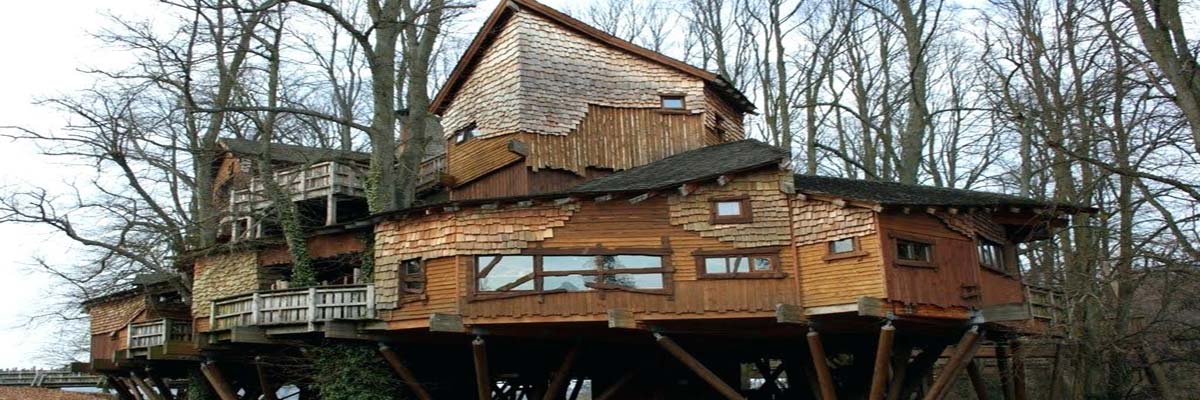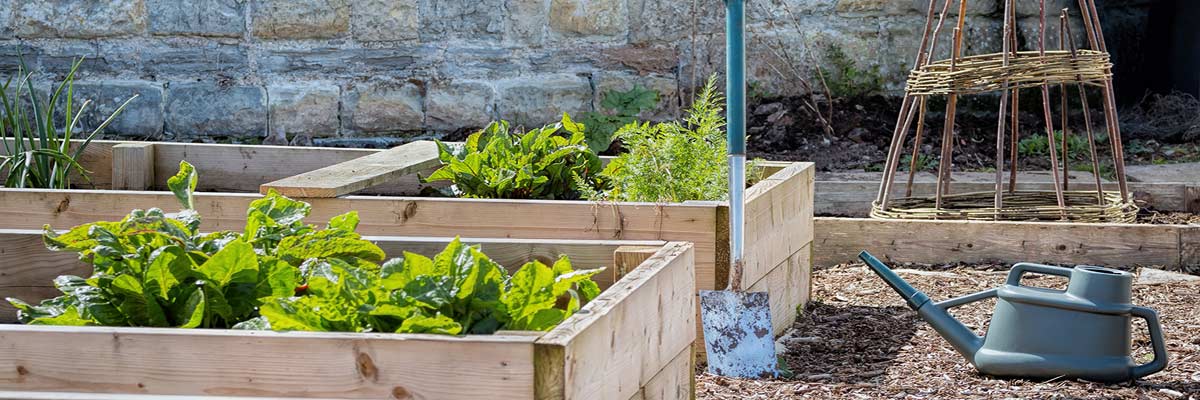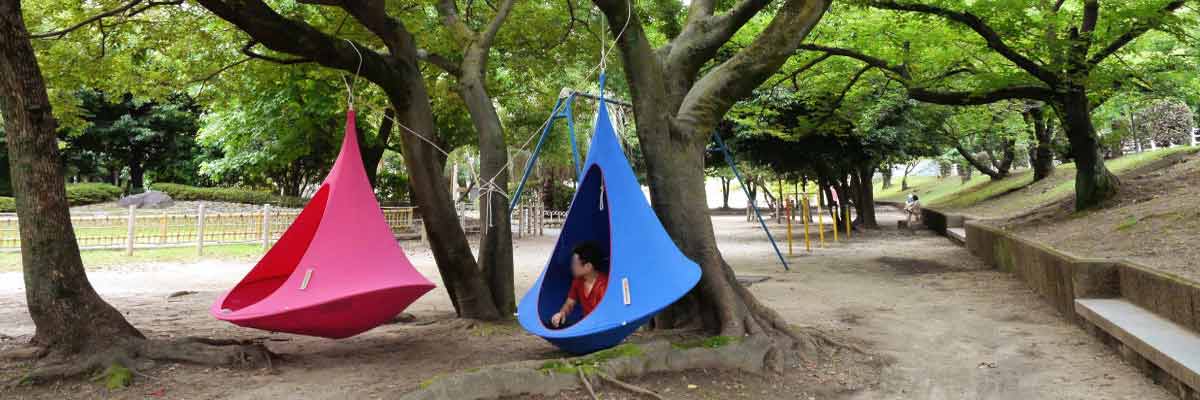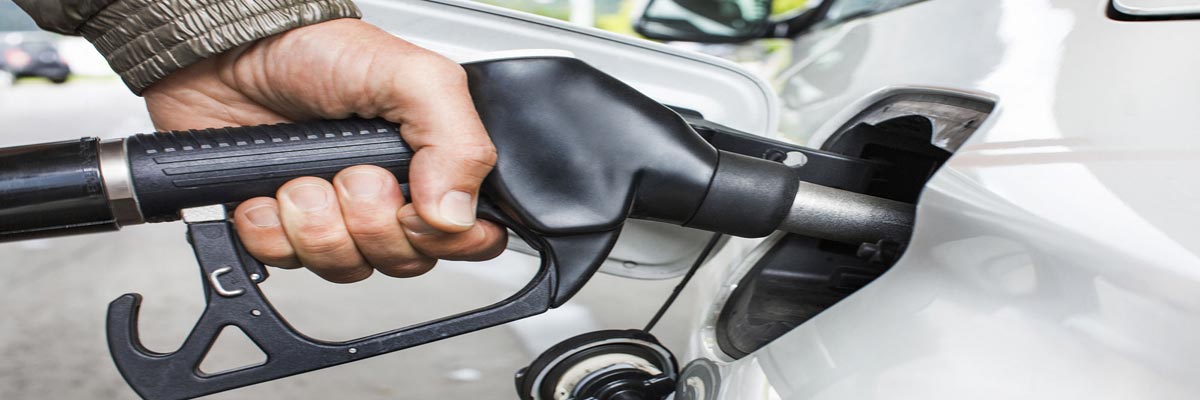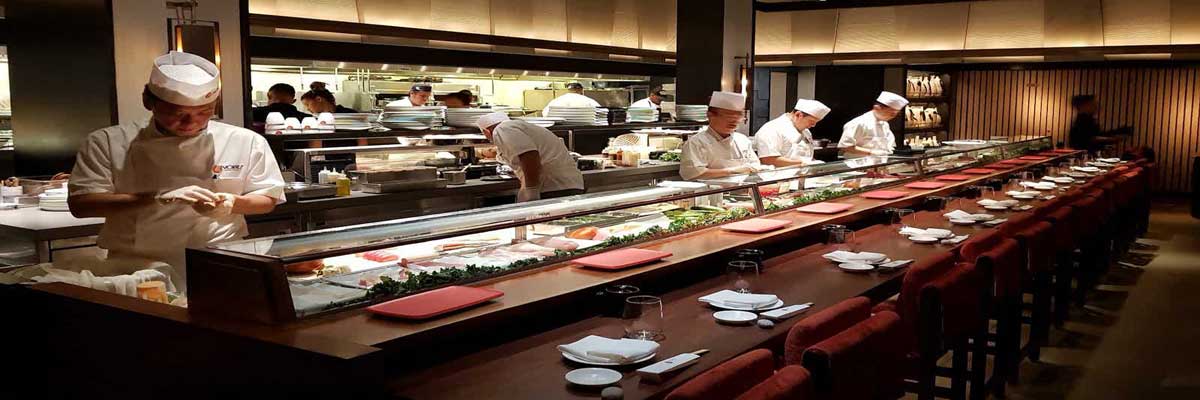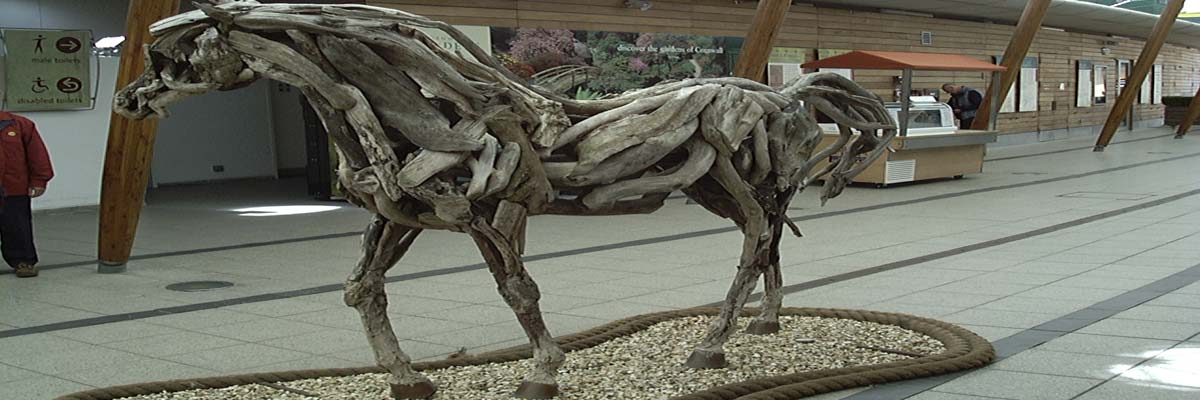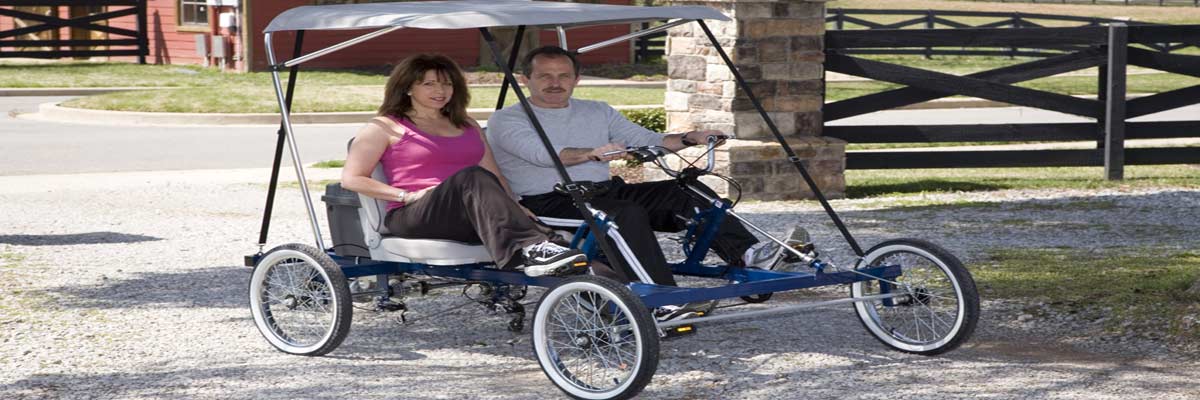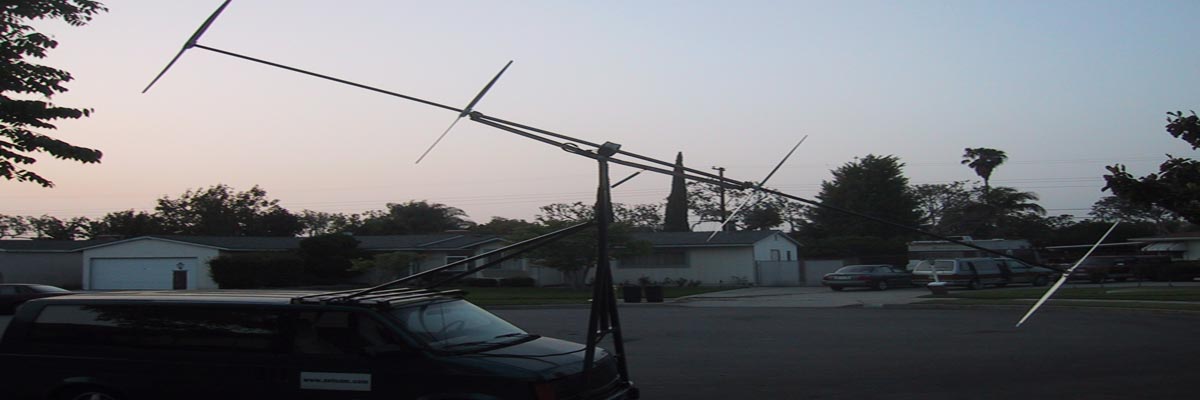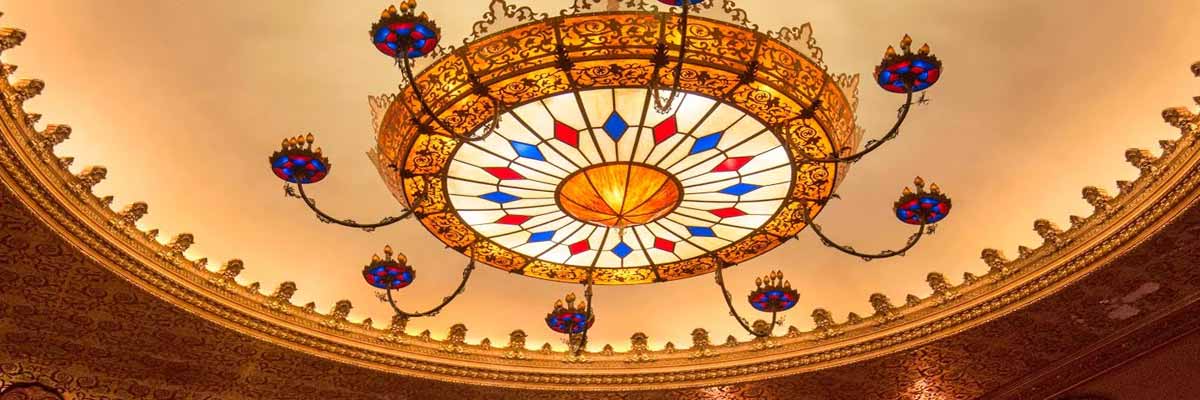All Hail The New Green Browser: Flock Eco!
Earth Day is quickly becoming not only an event to celebrate the planet — but also to look forward to a number of cool green technologies that love to launch on this iconic day. Already today, I’ve seen two great new developments: One, is Sungevity— a great online tool for Californians that displays a satellite map of your home, calculates solar installation costs, and mockups of what your roof might look like with the panels. Should you decide to purchase, the company takes care of all the details — including all the zoning permits and install crews. You just need to sign the dotted line. Awesome.
Next — and this is one we’re most excited about — is Flock Eco, a brand new take on the Flock Browser that comes fully loaded with green content AND gives 10% back to environmental causes every time you browse. Now, even reading your favorite sites can help generate money for worthy organizations! From the release,
World’s Largest Treehouse Cost $7 Million To Build
Like something out of a fairy tale — and seriously, even the main character’s name is Lord Northumberland — this 6,000 sq ft. tree house is the world’s largest. Located on the grounds of Alnwick Gardens, about 95 miles north south of Edinburgh, Scotland, the leviathan soars 56ft. above the ground and is connected with 4,000-square-feet of suspended walkways. There’s even a 120-seat restaurant — as well as wobble bridges, classrooms, turrets, and God knows what else. Naturally, this building was also built sustainably with the website saying Canadian Cedar, Scandinavian Redwood and English and Scots pine were all used in construction. Unfortunately, it appears that most of those were imported, so no points for you! From the website,
“The unique dining experience on offer in The Treehouse is nothing if not unusual. The roaring log fire in the centre of the room, the living tree complete with green leaves growing through the restaurant, the fascinating craftsmanship which has created screens from fallen branches and the dimmed lighting combine to create an other-wordly, magical environment. The delicious menus include a fantastic range of locally sourced produce, helping The Garden encourage and support local producers.”
Filter For Good Earth Day Giveaway
The good folks at Brita have given Groovy Green two sets of a Nalgene Bottle and a Faucet Filtration System to give away to our readers in celebration of earth day, and as a part of their FilterForGood Pledge.
How to win: Leave a brief comment letting us know what you plan to do this Earth Day, and make sure that you tell us your email address (Email addresses are not posted online from the WordPress comment form, only the editors will see them.) Two lucky readers will be chosen at random from the comments.
Also, check out FilterForGood.com today!. Take their pledge to avoid bottle water and use a refillable container.
Feeding The Suburbs
This is the last story in our series from Wendy.
***************************************************************************************
This evening, after I read Andrew Lost on the Dog to Precious, I sat back in my bedroom and thumbed through the March/April edition of World Ark, the magazine published by Heifer International. What struck me as I read through the articles was the statistic “85% of all farms worldwide are smaller than five acres” (15). Several articles, cited the fact that most subsistence farms in Third World countries are very small – some even as small as mine.
I was surprised.
I have a book someone gave me entitled Five Acres and Independence. I’ve had it for a while, and having that book seemed to reinforce my (mistaken) notion that in order to be self-sufficient, I needed an acreage. I needed land, lots of land and the starry sky above ….
At any rate, a 1/4 acre wasn’t going to do it.
I didn’t know that a large portion of the world’s farmers are working land that isn’t much bigger than the average American suburban lot.
Love Thy Neighbor
Another in our series from Wendy.
***********************************************************************************************
I had a rather nomadic childhood. For the first eight years of my life, we moved at a rate of about once a year. Then, we were settled for about five years, but we moved again just before I started high school, and then, four years later, when I graduated from high school, I lived a transient life as a college student. Four years later, when I received my Bachelor’s degree, I moved for the next seven years, at about the same frequency as I did for the first eight years of my life – packing up my entire household and relocating every two to eighteen months.
Then, I moved with Deus Ex Machina, our two month old daughter, eight month old chow-chow puppy, and three year old iguana to Maine.
The Sustainable Suburbs: Self-Sufficiency
Another in our series from Wendy. This one is about being self sufficient on a small plot, and if you really need to be.
************************************************************************************************
Someone told me recently that I could never be self-sufficient on my quarter acre suburban lot here in southern Maine. I don’t have enough land, and I can’t build a greenhouse.
Maybe. Maybe she’s right. But just maybe ….
My hero, Dolly Freed, lived on a 1/2 acre 40 miles from Philadelphia. She and her father weren’t “self-sufficient”, in that they did depend on outside sources for electricity, water, some food items, and clothing.
The folks at Path To Freedom aren’t self-sufficient, either. They buy bulk grains for themselves, feed for their livestock, clothing, and toiletry item ingredients (they make their own, but don’t produce the ingredients on their land).
Both of those examples are people who have very little land, compared to, say the settlers in the late 1890s, who were given 160 acres, but both of those examples are also people who live with very few “modern” conveniences on very small pieces of land with very small sums of money. In fact, their incomes likely fall well below what is considered the Federal Poverty level, and by our money-centric standards should be living in squalor.
If you think so, please do spend some time at the Urban Homestead. It’s anything but squalor. They even have a televsion, although I don’t believe they watch it very often, and they, obviously, have an Internet connection. While you’re at it, you should also, really, try to find a copy of Possum Living. It’s amazing what can be done, and how little cash one actually needs to live a very fulfilling life.
The Sustainable Suburbs: Fowl Language
Another story in our series from Wendy. This one has some nuts and bolts about the cost of keeping chickens in your backyard.
************************************************************************************************
I live in the suburbs. Mine may not be a “typical” suburban neighborhood – my house was not part of a “planned” subdivision, although a subdivision plan was filed with the town for the road on which I live.
There’s also a planned subdivision across the road from me. The house lots are each a 1/2 acre. There’s another planned subdivision going in right down the road from me. I know the owner of the property. He’s my neighbor and owns the garden center next door.
About a 1/2 mile up the road from me is another family who also has chickens. I think they might also have bees.
This is a residential area. It’s a suburb. With the exception of my home business, the few other home-based workers and the garden center, there are no shops or other stores – just a bunch of houses from Route One until the grocery store that is the beginning of the town proper.
There Was No Fat Lady Singing
The next in our series from Wendy.
********************************************************************************************
We watched the movie The End of Suburbia last night. I’ve been waiting a long time to see the film, but after having seen it, I’m actually glad that I didn’t have the opportunity to see it sooner. I like the timing of it all. Here, I’ve planned this series of posts about why we should stay in suburbia, and then the movie comes in the mail. It seems almost too fortuitous, almost fated.
Deus Ex Machina wasn’t as enthusiastic about the movie as I was (when he saw what it was he grumpled something about it being more of that fundamentalist crap). I asked Deus Ex Machina what he thought about the film after we watched it, and his response was, “They didn’t say anything new.”
Basically, the movie was a history of how our country adopted a suburban mindset. The original idea behind the suburb was to give city-dwellers the opportunity to move outside of the crowded and dirty environment of the newly industrialized cities into a cleaner community, usually consisting of residential housing with no industry or retail outlets within close proximity to where people lived. The hope was to give people a “taste” of country living.
Pass The Scoop, I Likes Me Some Ice Cream With My Cake
The next in our series from Wendy.
***************************************************************************************
I was supposed to be commenting on the Suburban Lawn of the Future, but I’m having trouble with that topic.
Ask me why.
Okay, I’ll tell you.
I live in Maine, and right now we’re under a foot-deep, concrete-hard blanket of ice and snow, which is not unusual for February in Maine, but it makes thinking about what my garden might look like in the spring a little difficult. Some of my favorite bloggers are starting seeds right now, and from my experience as a gardener in this part of the country, it’s still too early to even do that. The traditional planting date for Maine is Memorial Day – still three full months away (and I learned the hard way not to flout the wisdom of waiting until then).
Instead I hope I can talk convincingly about why, if you already live in the suburbs, keeping your house is a better option than running wildly into the woods, and I’ll be making the assumption that your house in the suburbs carries a mortgage AND that if you found a house in the country, you would also have a mortgage.
In a survival situation, experts stress that the first order of business is finding shelter. Most people freak out and rush around trying to get food. Read More
A Rose by Any Other Name
The next installment in our series from Wendy.
***************************************************************************************
What is a suburb?
As I was thinking about this post, I started having a really hard time defining what a suburb is. I mean, we all know what it is, right? It’s a planned, homogenized community with plastic-looking houses and artificially green lawns sporting pink flamingoes and rusty swingsets.
But if my goal is to defend suburban life and explain why I think people who live in suburbs have as good a chance of surviving the apocalypse as the people in the country who have a bajillion acres of land and an abundance of natural resources at their disposal, or people in the city who can combine or eschew resources such as transportation and heating, I can’t very well use that definition ![]() .
.
I googled the term and found this definition: town or unincorporated developed area close to a city. Suburbs, since they are largely residential, are usually dependent on a city for employment and support services and are generally characterized by low-density development relative to the city.
I think that pretty well explains what a suburb is, but again, if suburban dwellers are “dependent” on the city for support services and employment, then any illusion of self-sufficiency is immediately negated, by definition.
In short, by using either definition, when it comes to the apocalypse, we suburbanites are screwed.
So, let’s focus on what suburbanites have that is unique to their particular habitat, and might, with a little imagination, be used to their advantage.
1. Suburban homes have a yard space, usually between 10,000 and 40,000 sq ft. Not a lot, but more sometimes just means “more”, which isn’t always better.
2. Suburbs are “close” to amenities. While “close” really is subjective, and some people would say that anything within a 50 mile radius qualifies, I (and most of my suburban neighbors) would classify close as within walking distance. It would take me two to three hours to walk to Portland. It would take about an hour to walk to downtown Biddeford (Portland and Biddeford are the largest and the fifth largest cities in the state of Maine, respectively).
3. Suburban homes are usually single-family homes. People who escape to the suburbs want to have some sense of privacy, but recognize that being interdependent might not be such a bad thing.
4. Suburbs do not, typically, have any businesses (except for the occasional “home business”, that usually doesn’t attract on-site clients).
In other words:
If you measure your property by square feet rather than acres, you might be a suburbanite.
If you need extra storage space to house your lawn care apparatus and outdoor furniture, you might be a suburbanite.
If you live close enough to school to walk, but far enough away for them to send the bus, you might be a surburbanite.
If the only bus that comes to your neighborhood is the school bus, you might be a suburbanite.
If you could walk to town for the gallon of milk you need, but choose to drive, because it’s more than a mile, and that’s just too far to walk with those little kids, BUT you don’t think twice about putting on your sneakers and dropping little Sally into the jogging stroller and walking around the neighborhood for some exercise, you might be a suburbanite.
If you drive more than two miles, but less than ten, to buy plastic crap from China, you might be a suburbanite.
If there is no “corner store” in your neighborhood, you might be a suburbanite.
If you’re close enough to see the dirt on your neighbors’ windows, but need binoculars to see what’s on their big screen television, you might be a surburbanite.
If there is anything called a cul-de-sac in your immediate neighborhood, you might be a surburbanite.
If you live in a cul-de-sac … you are a suburbanite.
Avoid the extremes and converge in the middle.
That’s the suburbs.
Suburbs are the happy medium between country life and city life.
Up Next: Mary, Mary Quite Contrary: The Suburban Lawn of the Future
Oh, Give Me a Home…
Wendy, who writes an interesting blog, has been working through the pros and cons of living in the suburbs as we approach the Peak Oil energy descent. What I find most compelling about his discussions is that she is like any of us. She’s struggling to figure out if the suburbs are her home, or if she needs a house and some land to survive. While she talks about it she walks you through her thinking. Whether you agree with it or not, she make some compelling arguments. She has been kind enough to allow us to bring her serious of posts over to our site to share with a bigger world, which I will be doing over the next few days.
*******************************************************************************************
Today was a holiday. Seriously. It’s like President’s Day or something, I think. Anyway, my client’s office wasn’t open today, which means my normal “work day” was spent doing not much of anything. I sat on the computer most of the day … well, not “on” the computer, because that would have been very uncomfortable, and, well, I’m not sure my computer would have been able to support my weight – not that I’m big or anything.
Monsanto, How Evil Are Thee? Let me Count The Ways
Vanity Fair has a great article on their site featuring one of our favorite corporate villains, Monsanto. It is truly astounding the amount of evil doing that this one company can engage in.
From a business standpoint Monsanto certainly has the right to patent their genetically modified seeds, and profit and protect their profits with litigation from their business developments. But they do not have the right to give us products that suck. Their products suck. They spread all over the countryside. They don’t stay contained. In short, they act like plants. (Amazing, I know)
Monsanto as a company lies, incredibly, about what they are doing. They bribe officials around the world and they seem to treat the world as their toilet. That’s not right for the rest of us.
Treepee: A Tent That Truly Belongs In The Trees
If you’ve ever wanted to avoid contact with earthly critters or simply understand what it’s like to be a piece of fruit, the Treepee looks to be a pretty good way to do it. Just hang the tent from a sturdy tree, secure the corners, and you’ll be swaying pretty. From the description:
Four tethers, one on each corner, allow the Treepee to be secured for a less mobile ride. Bug nets on the windows allow air to circulate without letting any little critters in. The fabric is fire retardant, water repellent and PU Coated. The fabric has a UV protection factor of 50+. There are pockets on the inside for storage and a bag on a pulley which allows essential supplies to be hauled up into the ‘den’.
Want one? Start saving — the thrill of hovering will cost you about $600. But hey — at least you’ll be safe while your friends are carried away by fire ants.
Tapping Trees For Diesel Fuel
Australian farmers are embarking on a bit of an experiment to see whether or not they can self-sustain their production using diesel-producing trees. As some may know, I have a bit of a love-affair with plants that can produce — in one way or another — biodiesel. For those looking for an update to my “Adventures In Sustainability” series growing Jatropha — it’s coming soon. The plant is currently in hibernation. But I digress…
The diesel-producing trees are called Copaifera langsdorfii and are native to the Brazilian rainforest. The world has known of their unique properties since about the seventeenth century, but it’s only been recently that harvesting of the petrol is being planned on a grand scale. From the article,
Nobu Sushi Restaurants Use Fiji Bottled Water To Boil Rice
I shouldn’t be surprised. And yet, when I read that Nobu Matsuhisa — owner of the Japanese restaurant chain Nobu — uses Fiji Water to boil rice, I nearly laughed out loud. That was immediately followed by reverence for the power of branding; and lastly, slight depression over the mind-fuck given to the world courtesy of bottled water.
That glimpse into Nobu’s massive love for one of the fastest selling bottled water brands in the world came from an excellent article detailing the success and origin of the Fiji water label. Here’s a highlight:
Another golfer caught his eye and Gilmour watched as the man took a long drink from a European bottled-water brand. How bizarre, he thought, to come to a place like Fiji, where the water is famously pure, and choose to drink a European brand instead of the better and more available local stuff. Inspired, Gilmour founded a production company and signed a 99-year deal with the Fijian government to tap an ancient aquifer on the main island of Viti Levu. He called his brand Fiji Water.
GE Announces New Line Of Efficient Tankless/Hybrid Water Heaters
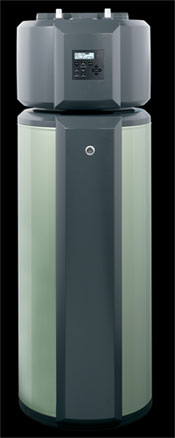 Tankless water heaters always seemed to make a lot of sense to me. I mean, hot water on demand as opposed to hot water sitting and waiting — seems smart, right? Everytime I go away on vacation, I lower the temp on my water tank to conserve energy, but I know I’m in a small minority. Most people probably go along heating water even when they’re not home for extended periods of time.
Tankless water heaters always seemed to make a lot of sense to me. I mean, hot water on demand as opposed to hot water sitting and waiting — seems smart, right? Everytime I go away on vacation, I lower the temp on my water tank to conserve energy, but I know I’m in a small minority. Most people probably go along heating water even when they’re not home for extended periods of time.
Which is why I’m jazzed about GE’s new line of tankless water heaters. For those that don’t need tankless, the electric-hybird heater they’ve got waiting in the wings looks pretty sweet as well. According to the release, the gas tankless on-demand heaters will “save 25 percent in water heating costs on an annual energy bill in comparison to a standard 40-gallon gas tank.” Additionally, the unique design can help avoid up to 25 percent of CO2 emissions tied to water heating.
Even better, earlier today the U.S. Department of Energy created the first ENERGY STAR standard for water heaters. Ironically, water heating was the only major residential energy product that did not have an ES designation — even though it’s one of the largest energy consumers in the household.
Of course, not everyone has access to gas (and truly, for those of us building green homes, reducing the use of fossil fuels is probably on the short list) so GE is getting ready to launch an Electric-Hybrid water heater for next year. According to early tests, this hybrid would reduce typical water heating energy consumption by more than half. While the typical home might use 4800kwh/year, the GE model consumes only 2300kwh/year. Plus, it would retain the same footprint of standard water heaters allowing easy installation.
The Green Picture: Amazing Recycled Drift Wood Horses
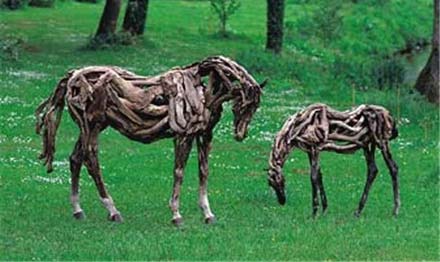
If you looked quick enough, you might be mistaken that this is a real horse. Instead, it’s a sculpture put together with pieces of recycled driftwood. The work is the result of artist Heather Jansch — who specializes in art created with driftwood and bronze.

The Green Picture: The Lexus Of Human-Powered Bicycles
The Rhoadescar is one of the swankiest human-powered two seaters I’ve seen yet. Especially with the top up to keep the rain/sun out. Granted, you probably won’t fit in the bike lane — and the highway will be a bit of a challenge, but I did it nonetheless.
The Selsam SuperTurbine Will Submerge During Rough Seas!
The Selsam SuperTurbine is one of the best designs I’ve seen yet for a wind turbine that can survive the hostile open seas. It also looks like it might be a bit of a bitch to navigate through with a tanker — not to mention the description states “the SuperTurbine probably won’t sink a vessel.” Makes you feel warm and cozy inside, doesn’t it? Still, based on designs, it looks like the pitch of the turbine should be high enough to keep you safe.
The advantages of this design are many. First, during large and fierce storms, these deep water turbines may intentionally lay down by flooding chambers, or even completely submerge to survive. Bonus! Second, flotation near the surface forms a fulcrum, with the weight of the rotors and driveshaft balanced by a downward force from the mooring below. According to the site, this allows the turbine to bend similar to arching your back to take advantage of wind patterns much more easily. Additionally, the rotors can be staggered, spiral, or in line.
World’s Largest LED Chandelier Is Beautifully Green
Behold! The wonderful efficiency of next-gen LED lighting is now being integrated with the grandeur of luxury illumination — specifically, massive chandeliers. Even more specific – the world’s largest chandelier currently installed at the Stanley theatre in Utica, New York.
This chandelier — weighing in at almost 7,000 pounds, 35 feet in diameter, 17 feet tall — uses 328 LEDs manufactured by Philips Luxeon and consumes just 1,120 watts of electricity. That’s almost seven times more efficient than conventional light bulbs. Not to mention the fact that will be many years before workers have to replace any of the bulbs due to burnout. Unless, of course, the Phantom has anything to say about it.
Damn Phantom.

